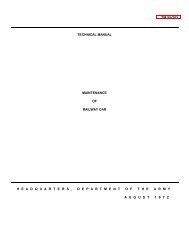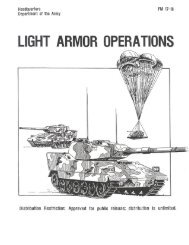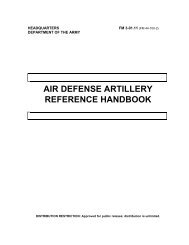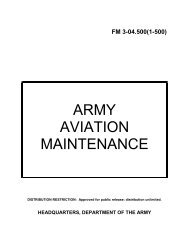fm 44-100 us army air and missile defense operations
fm 44-100 us army air and missile defense operations
fm 44-100 us army air and missile defense operations
You also want an ePaper? Increase the reach of your titles
YUMPU automatically turns print PDFs into web optimized ePapers that Google loves.
FM <strong>44</strong>-<strong>100</strong><br />
6-22<br />
systems <strong>and</strong> attack helicopters that the comm<strong>and</strong>er can employ rapidly<br />
against enemy <strong>air</strong> throughout the depth of <strong>operations</strong>. If enemy fixed-wing<br />
<strong>air</strong>craft <strong>and</strong> helicopters are expected, then mobile ADA assets that can counter<br />
this mixed threat are crucial to the deep operation.<br />
6-96. Rear area <strong>air</strong> <strong>and</strong> <strong>missile</strong> <strong>defense</strong> includes <strong>operations</strong> by both short<br />
range <strong>and</strong> high- to medium- altitude <strong>air</strong> <strong>defense</strong> systems throughout the battlefield.<br />
The size of the area, however, requires the weighting of ADA resources<br />
around those facilities <strong>and</strong> assets that the comm<strong>and</strong>er determines<br />
are most critical to the concept of operation. HIMAD forces protect priority<br />
forces <strong>and</strong> assets from attack by TMs <strong>and</strong> fixed-wing <strong>air</strong>craft. Short range <strong>air</strong><br />
<strong>defense</strong> is added to the highest priority forces <strong>and</strong> assets to screen against<br />
RSTA attempts, destroy cruise <strong>missile</strong>s or attacking fixed-wing <strong>air</strong>craft, <strong>and</strong><br />
to provide a mix of weapons systems. Major ports, railheads, <strong>air</strong>fields, assembly<br />
areas, <strong>and</strong> storage areas are assets normally requiring dedicated<br />
SHORAD protection. CAFAD employment is also a means of <strong>air</strong> <strong>defense</strong> protection<br />
in the rear where <strong>air</strong> <strong>defense</strong> systems are not available. In these areas,<br />
smoke screens can reduce the vulnerability of rear area facilities <strong>and</strong><br />
might even be <strong>us</strong>ed for LZ <strong>and</strong> PZ denial.<br />
6-97. Passive <strong>air</strong> <strong>defense</strong> actions reduce the effectiveness of the <strong>air</strong> threat.<br />
The extent of an asset's passive <strong>air</strong> <strong>defense</strong> efforts directly impacts on the<br />
vulnerability of that asset. Regardless of the type of theater or area of the<br />
battlefield, the ADA concept of <strong>operations</strong> always includes passive <strong>air</strong> <strong>defense</strong><br />
measures. Based on the force comm<strong>and</strong>er's <strong>air</strong> <strong>and</strong> <strong>missile</strong> <strong>defense</strong> priorities,<br />
not all assets will receive dedicated ADA forces for protection. However, most<br />
assets will receive a degree of <strong>air</strong> <strong>and</strong> <strong>missile</strong> <strong>defense</strong> protection from coverage<br />
provided by higher echelon <strong>and</strong> adjacent ADA units. To enhance the protection<br />
available from this <strong>air</strong> <strong>and</strong> <strong>missile</strong> <strong>defense</strong> coverage, all elements<br />
m<strong>us</strong>t plan <strong>and</strong> employ passive <strong>air</strong> <strong>defense</strong> measures. Integrated active <strong>and</strong><br />
passive <strong>air</strong> <strong>defense</strong> makes the <strong>air</strong> threat expend maximum resources with a<br />
minimum of success. Based on the threat <strong>and</strong> scheme of maneuver, assets<br />
may need support to enhance their passive <strong>air</strong> <strong>defense</strong> posture. All members<br />
of the combined arms team m<strong>us</strong>t integrate the support requirements for passive<br />
<strong>air</strong> <strong>defense</strong> into the prioritization of tasks for their forces.<br />
6-98. Vulnerability of a friendly asset depends on the extent of signature reduction,<br />
concealment, hardening, <strong>and</strong> deception employed. Signature reduction<br />
makes the battle comm<strong>and</strong> asset difficult to locate <strong>and</strong> less subject to attack.<br />
Engineer units can increase the hardness of the battle comm<strong>and</strong> asset<br />
by constructing field fortifications. Even if the battle comm<strong>and</strong> asset is attacked,<br />
the site is less vulnerable. Establishing a decoy may result in enemy<br />
<strong>air</strong> threats attacking the wrong location.<br />
Task Organization <strong>and</strong> Comm<strong>and</strong> or Support Relationships<br />
6-99. An ADA comm<strong>and</strong>er structures ADA forces unit by unit based on the<br />
concept of <strong>operations</strong>. The comm<strong>and</strong>er considers the stat<strong>us</strong> of unit leadership,<br />
personnel, equipment, experience, <strong>and</strong> training to determine the best ADA<br />
task organization. In determining task organization, the comm<strong>and</strong>er selects<br />
the appropriate comm<strong>and</strong> or support relationship for each unit.











